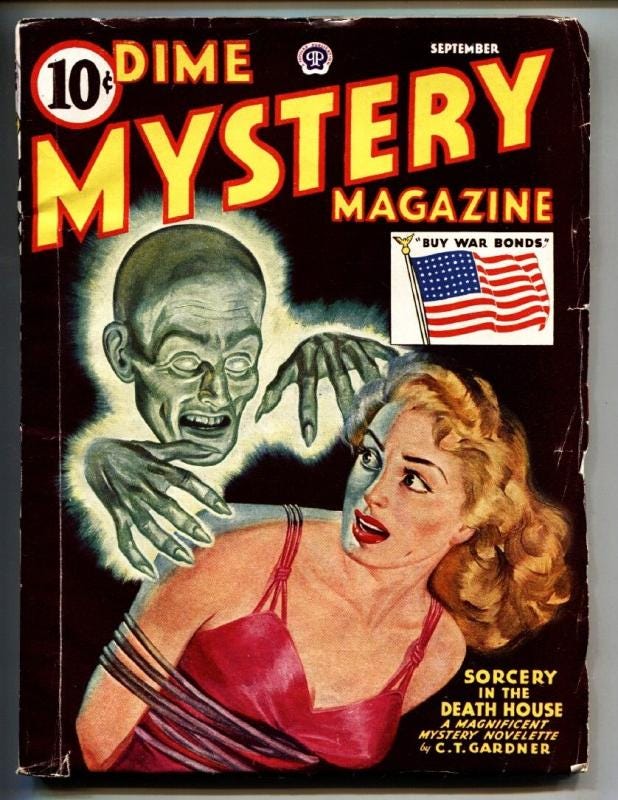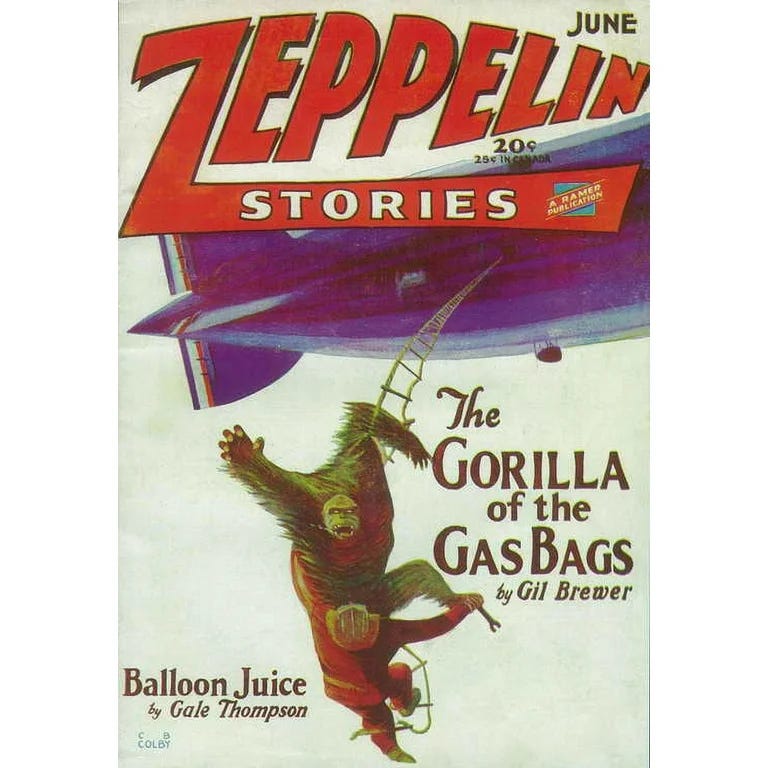Way Out There! Five Unique Pulp Sub-Genres
Meet the most fascinating sub-genres of the pulps!
Recently, a friend of the Bizarchives asked me to compile a list of the most interesting and exciting sub-genres of pulp fiction. Since I am not one to disappoint, I would like to herein present a brief and concise look at the five pulp sub-genres that I find the most intriguing. You may agree or disagree, but you cannot say that these odd pulp styles are boring.
Weird Menace
Also known as the “shudder pulps,” the weird menace sub-genre is a bloodthirsty and salacious mashup of horror and mystery fiction that began with the October 1933 issue of Dime Mystery. In weird menace tales, a squared-jawed hero usually has to rescue some dame from the clutches of what seems to be a supernatural foe. Eventually, after defeating monsters and putting voodoo curses to rest, the hero realizes that otherworldly evil is actually all too human. Think Scooby-Doo in that weird menace yarns always pull back the curtain and show that no ghosts need apply. Although this may sound like kid stuff to our ears, the often violent and lurid weird menace stories were seen as so vile that New York City Mayor Fiorella La Guardia tried to yank the mags off the shelves by revoking their mailing privileges in the city. Thankfully, the weird menace mags, with their hooded sadists and half-naked victims, prevailed.
Example of a weird menace story: “The Corpse Factory” by Arthur Leo Zagat
“Spicy” Fiction
There’s nothing necessarily original about the spicy pulps. In fact, spicy stories may be among the oldest in recorded history. Pornography has been with mankind in some form or another since the dawn of time, and the spicy pulps were just the Jazz Age incarnation of sex stories. Softcore sleaze that mixed adventure with horror, mystery, and action, the spicy mags presented a hodgepodge of specialists and some writers who “slummed” it in the nudies just to earn extra money. Just like the weird menace mags, the spicy sub-genre was often singled out for being morally depraved. (Not helping matters was the fact that these magazines often had nude women on the covers.) Out of all the spicy stars, Robert Leslie Bellem’s Dan Turner, Hollywood Detective was arguably the most popular. Bellem’s private eye is a tough-talking, two-fisted shamus who makes his clams dealing with Hollywood’s studio executives and starlets. And some of these starlets get naked!
Example of a spicy story: “DA’s Daughter” by Wallace Kayton
True Crime
The true crime genre is ubiquitous these days. From YouTube to TikTok, you cannot escape mildly attractive women talking about serial murder while doing their make-up. “True crime brain” is a real thing, and it often results in everyday people thinking that they know more about investigative work and the judicial system than the actual professionals. Well, long ago, during the heyday of the pulps, true crime, the bastard son of the mystery genre, became a bestseller, as magazines such as Master Detective and True Detective titillated their audiences with real (although highly exaggerated) cases of murder, gangland warfare, and dismemberment. Some of the later greats of American fiction, like Jim Thompson, got their start penning bloodboilers for the true crime pulps.
Example of a true detective story: “Tong War!” by Yee Kong
Space Opera
The pulps were fantastic for experimentation. Besides injecting new life into well-worn genres, the pulps also innovated and created, thus modern science fiction and sword & sorcery were both children of the pulp magazines. Space opera, a sub-genre of sci-fi, got its start in the 1930s, when sci-fi writers began emphasizing melodrama and romance in their daring tales of intergalactic warfare. Often gigantic and grand in scope, the space opera stories blazed the path for what would become the Star Wars series. However, these days, the snoots that run sci-fi tend to see space opera yarns as immature, regressive, and toxic for their reliance on tropes like masculine courage and alien savagery.
Example of a space opera story: The Skylark of Space by E.E. “Doc” Smith.
Zeppelin Pulps
At one point, especially after the ferocious raids on London during the First World War, the slow-moving dirigible seemed to be the future of aerial combat. Zeppelins became all the rage, and of course the pulps had to cash in on this fascinating piece of tech. Zeppelin Stories was launched by Ramer in 1929, and the genre had its first masterpiece with Gil Brewer’s “The Gorilla of the Gas Bags.” Later, following the February 1935 crash of the U.S.S. Macon in California, the U.S. Navy leaned on the pulps to improve its image. Enter Don Wislow of the Navy—an intelligence officer who travels by zeppelin in order to complete sensational missions all over the world. This comic strip, along with new pulp magazines like Complete Zeppelin Stories, tried to settle public nerves about blimps. However, that all came crashing down with the Hindenburg, and thus the zeppelin pulps were scuttled. Still, it’s pretty cool that the pulps could be so niche that they had entire magazines dedicated to adventures taking place on floating blimps in the sky.
Example of a zeppelin story: “The Gorilla of the Gas Bags” by Gil Brewer. Good luck finding it!
This is merely a simple snapshot of the pulps from their peak of popularity. Other sub-genres, from vigilante books to boxing and Western pulps, also thrilled readers between 1920 and 1945. Furthermore, hardboiled detective stories, cosmic horror, weird horror, sci-fi, sword & sorcery, and weird war stories all got their start in the pulps, and today such fiction is commonplace in our consciousness. The more you dig into the pulps, the more you realize just how important and influential they were and remain.






BRING BACK ZEPPELIN PULP!